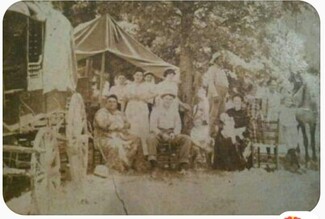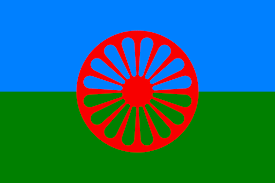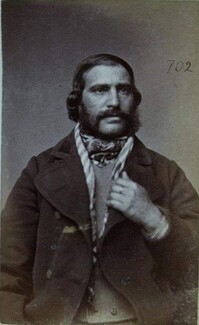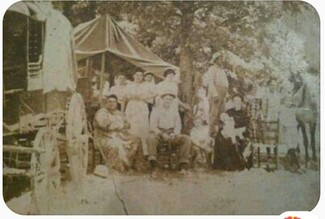A call to submit designs to the Romanichal-Romanisael flag project by Lizzie Isaacs

A flag commitee, headed up by Lizzie Isaacs in England, Amanda Schreiber and Jack Pearce in America and Paul Roos in Sweden are welcoming all Romanichal and Romanisael to submit designs for a new Romani flag as part of the Romanichal-Romanisael flag project.
I love our Romani flag, we all do, it’s what unites us with all Romani groups as a race of people........writes Lizzie Isaacs.
It was established in 1971 in Orpington Kent by a group of activists fighting for Romani rights and recognition. We have been and continue to be proud to carry this flag to show our unity with all Romani groups around the world. However, almost 50 years on, a group of Romanichals from all the host countries, myself included, now feel it’s time to celebrate our unique individuality as a legitimate tribe, for the want of a better word, and be proud of our own recent history since coming to the British Isles ,America, Scandinavia, South Africa, Australia and New Zealand. We have decided to celebrate by producing a new flag for ourselves, not a replacement for the original, but one to carry alongside of it to show exactly who it is that stands united. We will always unite with our continental cousins and support the Travelling communities. Although we also feel that for many years we have been apathetic to our own culture, carrying on in tradition but not really having the knowledge of where we came from or who we truly are.

Origins of Romanies will always be debated, so will the “why” and the “when”. What we know for certain is that we are a race of people who started in the East about 1000 years ago and travelled Westwards, stopping in various countries along the way forming tribes and clans as we went. We also know our language, which has common core words throughout the different tribes, has its origins firmly in old Indian Sanscrit. It is thought the tribes started to form around the Balkans and that Western Romanies like the Sinti, Manouche, Kale and Romanichal are from the first wave across Europe. Somewhere in mid Europe these tribes split and went their separate ways.
There is evidence to suggest that the Romanichal tribe split before they entered Britain and that some members of the group travelled North through Denmark to Sweden and Norway, where they were conscripted into the Swedish army in exchange for passports into the country. They became the Romanisael that resides there in Scandinavia today. The rest of the group entered Britain, the first known record of Romanies in Britain was in 1505 in Scotland, and in 1514 in England, there is however, every possibility they were here for some time before that. They didn’t all get to Britain at once; there was probably a steady trickle that took many decades. “Romanichal” was their name for themselves at the time. Although, after being mistakenly thought of as coming from Egypt the name “Gypsy” was born.
It wasn’t long after the arrival of Romanies in Britain when the first act of parliament was made concerning them. The Egyptians act of 1530, under the orders of King Henry the 8th, was put into place to persuade Romanies to give up their ways or face deportation; it was later upgraded in 1554 to a death sentence. It was during the early years that Scotland started to deport Romanies to Denmark.
In recent months a group of us from England and America have had the privilege of getting to know our cousins from Scandinavia, the experience, however, has been bittersweet. Exciting to find links and share stories but sad when we were told of some of their experiences. Scandinavian Romanisael have had a very sad and troubled history, one that would bring even the hardest hearts to tears if they hear it. I was told that the blueprint for Hitlers annihilation program was designed in Sweden at the worlds very first race biological centre where they carried out studies on Romanies unofficially from 1909 but then officially from 1922. Herman Goring, one of the most powerful figures of the Nazi party, had links to Sweden and was married to the daughter of a Swedish baron. At the same time the Swedish Royal family were huge admirers of Adolph Hitler, allegedly. I have also heard from those that live there, about a concentration camp in Norway which was the biggest holding camp for Romanies awaiting deportation to Auscwitch during the Holocaust. Ironically, the end of the war came before they were deported but instead of being released they were kept in the camp, whole families, until the 1980s. They were threatened with losing their children if they tried to leave.

I heard also of a sterilisation program for Romani men and women right up until 1975, as well as the horrific experiments of lobotomising Romani individuals, which resulted in many being sent to mental institutions where they suffered unimaginable cruelty. I have to say that when I heard this, I found it very distressing, but then I heard about the widespread policy to remove Romani children in Sweden and send them to America and Canada to be adopted out to non-Romani parents, I was heartbroken. I could only think of parents waiting for the day their child might come home, with the full knowledge that maybe they never will. I don’t believe that an adequate apology has ever been issued to those who suffered during this time and the effects of such events have been long lasting among our people there. I felt very humbled when our new Scandinavian friends Paul Roos and Kenneth Bergsten said “Thank you to Britain and America for stopping the mad man of Europe”. It was at that moment when those of who were privy to that conversation pledged our friendship and support to our people there, promising that they’d never feel alone and isolated again.
In Britain was a similarly sad history but probably not quite as bad as our neighbours on the other side of the Norwegian Sea. After the Egyptians act, came the Vagrancy act. If you were caught without a real home or place of abode you could be sent to prison, and when I say “prison” I mean “Hard labour” in the harshest of conditions. There are records of my own extended family, which included a grandmother, Rhoda Small with her children and baby grandchild, in the 1860s in Cornwall who were sent to Bodmin jail for 21 days for the simple crime of “Sleeping in tents”. This was not an isolated case, in fact it was commonplace. I found my great great great Grandfather, Moses Small, in 1810 in Dorchester Jail, serving hard labour along with his parents James and Jane. Moses was five years old and labelled as a vagabond. Britain has been very cruel over the years with specific laws directed at Romanies and other Travellers and I don’t mind being so bold as to say so.
It’s not surprising, that when the New world, America, was attracting so many people, how inviting did it seem to those who were facing such oppression in Great Britain. If America could entice the settled people from all over Europe, how much more could it entice the very people that had travelled for centuries? In the mid-1800s the Romanichal who had travelled the roads of Britain for three hundred years were ready to cross the Atlantic ocean for a chance of a new life. Many families from Britain took on the journey, including my own great great great grandmother Sophia Small and her children. I often wonder if they intended to stay, or did they just think they would go , earn their fortune and come home. Sophia had one daughter, Caroline, who was already married at the time her mother left and she was the only one in that family to stay in England. Two months after arriving in America Sophia died and is buried in Ohio, on her gravestone, so I’m told it says “Sophia Small, A Gypsy”. Sometimes, when I think about them, I feel it was like they all went off to have an adventure, and they didn’t come back. How long did it take for them to forget? I know they would have forgotten us, because as the generations went on they were forgotten too. Oh for sure, Caroline would have remembered her mother and siblings but their names never made it down through the ages. When years later Caroline sent her own son Moses to America all we heard was that he “went with his cousins” but their names, who they were, how they were related, had been forgotten.

I guess America was probably the kindest of all the countries towards our people, being made up of multiculturalism itself but make no mistake, Romanichals were, and are still subjected to prejudice, bigotry and unfair portrayal there. Despite being across the ocean from us, American Romanichals have maintained the essence of what it means to be Romani and have kept and preserved the traditions, customs and taboos that we all observe. In general, it seems, the American cousins have a better command of the Romani language then we do in Britain. From this little county of Devon where I live, in the southwest of England many families I am connected to left and didn’t return. As well as the “Small” family, other well-known family names like Harrison, Stanley, Buckland, Cooper and Broadway all took on the journey. It would be over one hundred and fifty years until we found each other again. I asked my new found cousin, Jack Pearce, once, if any of them ever thought of coming to England, he said “Sure we did but we didn’t know anything other than our family came from England, we didn’t know where to start looking”.

With the internet so readily available to everyone now, it’s easy to make connections and find our cousins and that’s just what we’ve done. We’ve found our families in America and also the ones that split from us in Europe and ended up in Scandinavia. I personally have found and made some very dear friends across the water and feel privileged to have done so. We also have our own families who went to Australia and New Zealand during the 60s and 70s and made their lives there. Not forgetting those who stayed in South Africa after the Boar war. Our Romanichal tribe is big and widespread and although for many years we were fragmented, we are now united. It’s like we were broken and didn’t know where the pieces were, but now we have found the pieces and we are being put back together.
This is the reason for the Flag! - a celebration and a pledge of unity for all Romanichal no matter where we are in the world we are part of something big. It’s also the start of a new era. I have another new found distant cousin in America, “Amanda Schreiber” who, along with others, runs a Romani DNA project. DNA has been a contributing factor in finding our people as well as the trusted paper trail in family research. It was whilst in conversation with Amanda one day during last summer that the idea for the flag was conceived. It was Amanda who said “We need a Romanichal Flag” and I ran with it, putting it out on social media to test the response of the Romanichal public. I even thought how good it would be if all the Romani groups had a flag, like a family crest if you like. We’ve since heard that Scottish Travellers have their own flag and English Travellers are in the process of making one too. So , it seems, a flag is something most people identify with.
At first the idea was met with caution as people feared it would cause a split between us and other Romani groups and Travellers. But there was also a great enthusiasm for a new flag, for a flag that would give us an identity, a legitimate one among all the other groups. The need for acceptance was expressed throughout, people who had never spoken out before started to support the flag vocally, it gave a new hope to those who had no hope before. The thought of our own flag is giving a pride to a people who had lost their pride and started to think they’d never get it back. For those who gave up all hope of being heard it’s giving them a voice and a courage to use that voice. Our people need to fall in love with their own culture again and stop being afraid of the outside world. We need to feel valued and respected and start to see ourselves as a positive contribution to society instead of letting ourselves be dismissed as a negative influence.
For the past five hundred years we have been told what we are by outsiders. We are “Gypsies”, we are “Travellers” we are “Thieves, Rogues Tramps, and Vagabonds”, all these names have been given to us not by our own choosing while our rightful name was taken from us. But today there is a new dawn and a new vision. My friend Shane McNeil, said to me recently “To know where you came from enriches you but to know where you are going is priceless”. Our people will know there is a better future, one where they are encouraged to be the best they can be. We want our people to have the confidence, to stand up for themselves and to hold their heads high and when they say their name it can be said with pride, We are the Romanichal!
There is a flag commitee, headed up myself in England, Amanda Schreiber and Jack Pearce in America and Paul Roos in Sweden. We welcome all Romanichal and Romanisael to submit designs for the flag that will represent us all. There will be a vote for the most popular design in the coming New Year. You can follow us on Facebook “Romanichal-Romanisael flag project” or see the website for rules and guidelines https://romanichalflagproject.com/